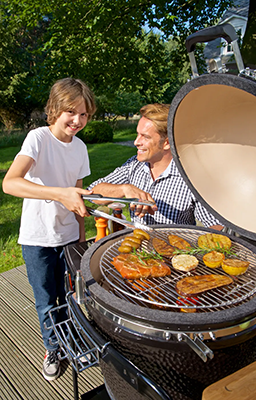When is meat cooked?
What one person considers cooked, another considers raw. In restaurants, people use standard expressions for the degree of doneness.

The above expressions refer to better cuts of meat. Indeed, these are lean (little fat) and tender by nature because they are cut from muscles that have done little work. Muscles that have had to plow are tough and can only be tenderized by cooking for hours (at low temperature). That meat is only tasty when it falls effortlessly off the bone and can be pulled apart in threads. There are no fancy subdivisions for that degree of doneness. It’s buttery or not.
There are tricks to determine the degree of doneness, but each one is as reliable as sticking a wet finger in the air to predict the weather. You can’t tell or feel from the outside of a (large) piece of meat how cooked the inside is. The only correct way is to use a core thermometer on which you can read the temperature.
The brown color on the outside of meat or fish says nothing about the degree of doneness. During grilling, foods turn brown and this browning is called the cornflour reaction. It is a chemical reaction between reducing sugars and amino acids under the influence of heat. In principle, the Maillard reaction works at any temperature, but the lower the temperature the slower the reaction proceeds. Therefore, it is advisable to first roast large pieces of meat that are going to be cooked slowly and at a low temperature on a high heat for a while to give them a nice golden brown crust.


- Chopped/Sausage
Minced meat (including hamburgers) and ground meat should always be heated through and through. The reason a steak does not necessarily need to be fully cooked is because only its outer surface is exposed to bacteria. When frying or grilling, the high temperature kills these bacteria. When meat is minced or ground, however, those bacteria are mixed throughout the meat (where they multiply at lightning speed), so just heating the outside sufficiently is not enough. The bacteria on the inside must also be eliminated by sufficient heating (at least 70 to 75 degrees).
Note: Meat should always be left to rest for a while before cutting and serving. During this resting, the cooking process continues slowly. Allow for about 1 to 2°C. This resting causes the meat juices to become slightly more viscous and therefore run off less when cut. This adds to the flavor. Resting also makes the meat more tender.







